New dimension in aquaculture may support organic status

The term periphyton refers to the entire complex of aquatic biota attached to and associated with submerged substrates. The principle of periphyton-based aquaculture, derived from traditional brush-park fisheries, is to provide substrates on which bacteria, protozoa, fungi, phytoplankton, zooplankton, benthic organisms, and a range of other invertebrates colonize.
These organisms supplement artificial feed. The hard substrates also act as shelter and minimize the territorial effects of cultured animals. Nitrifying bacteria can colonize the substrates in a well-oxygenated water column and improve water quality through higher rates of nitrification.
In recent years, the concept of periphyton-based aquaculture has been tested and applied with varied degrees of dependence on periphyton as food or substrates as shelter for cultured animals. For finfish, the reported increases in production due to substrates have ranged 30-115 percent in Indian major carp monoculture and 30-210 percent in carp polyculture, depending on the amounts and types of substrates used, cultured species, nature of ponds, feeding and fertilization practices, and other management aspects.
Tilapia, prawns in periphyton polyculture
Recently, there has been significant interest in the polyculture of freshwater prawns (Macrobrachium rosenbergii) with finfish, especially Nile tilapia (Oreochromis niloticus). Interest in freshwater prawn culture has increased because of environmental controversy and disease outbreaks related to penaeid shrimp farming.
Tilapias are important aquaculture species due to their ease of farming, favorable product characteristics, and wide acceptance by both rich and poor consumers. Tilapia can be raised in systems that range from back-yard ditches relying on natural foods to intensive recirculation systems depending on complete formulated diets. The fish are highly opportunistic eaters, and this is one of the reasons for their success both in the wild and in culture. They are known to graze on periphyton, as well.
The authors’ preliminary research findings indicated that production of these two species in substrate-based ponds is higher than in ponds without substrates in monoculture systems, but there was a need to further fine-tune their polyculture in periphyton-based systems. The authors therefore carried out studies in small farmers’ ponds. The research was done as a doctorate project funded by the United Kingdom Department for International Development (Fisheries Training and Extension Project, Phase 2), the Bangladesh Department of Fisheries, European Community, and the Wageningen University and Research Centre in the Netherlands.
Research trials

Four experiments were completed at the Bangladesh Agricultural University in Mymensingh, Bangladesh, or in nearby villages. Bamboo poles were used as substrate for periphyton development based on their performance and availability in this region. The poles were inserted vertically into pond bottoms, providing a submerged surface area of approximately 60 percent of the pond’s water surface area.
The experiments were carried out in ponds with or without substrates. Both monoculture of tilapia stocked at 20,000 juveniles/ha and polyculture with 20,000 tilapia plus 20,000 prawn postlarvae/ha were studied. The tilapia and prawns were fed a 25 percent-protein feed at 2 percent body weight/day. The ponds were fertilized with urea and triple phosphate.
The effects of substrates on both tilapia and prawn production, as well as prawn addition on tilapia production were investigated. Also, the optimum stocking ratio and density of these two species were determined. Finally, using the best stocking ratio and density, the effects of periphyton substrate and supplemental feed were compared.
Effects of substrates, culture strategy
Substrate addition resulted in 5 percent higher tilapia survival and 45 percent higher tilapia production, while prawn survival increased from 20 percent to 35 percent, and production rose 127 percent (Figs. 1 and 2). However, neither survival nor production of tilapia was affected due to the addition of prawns to tilapia ponds, indicating the feasibility of mixed culture of these two species. The highest total yield of 2,445 kg/ha tilapia and 141 kg/ha prawns over a 145-day culture period was recorded in substrate-based polyculture ponds.
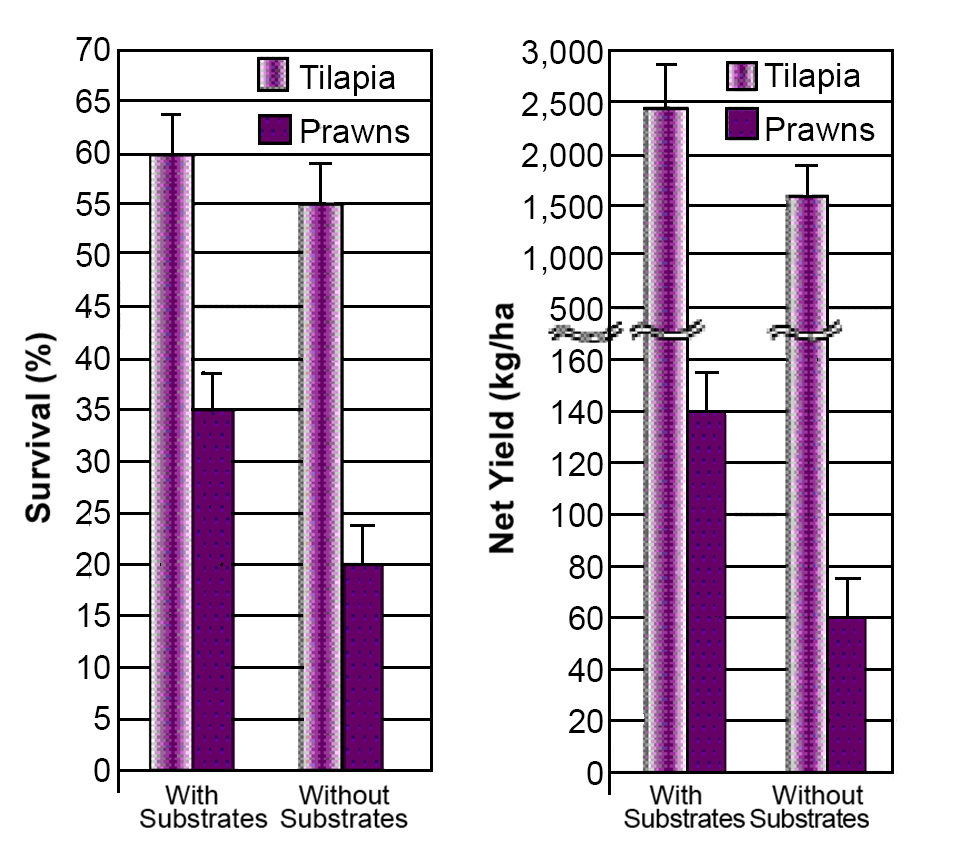
The authors also checked whether there were significant dietary competitions for natural food between tilapia and prawns by gut content analysis. Since both species were found to strongly prefer phytoplankton above zooplankton, there was considerable overlap in their food preferences.
Stocking ratio, density
With a total stocking density fixed at 20,000 animals/ha, five stocking ratios were tried in fed and fertilized ponds with substrates: 100 percent tilapia, 75 percent tilapia with 25 percent prawns, 50 percent tilapia with 50 percent prawns, 25 percent tilapia with 75 percent prawns, and 100 percent prawns. The highest production – 1,623 kg tilapia/ha and 30 kg prawns/ha in four months – and net return of 53,000 Bangladesh taka ($765)/ha were recorded at a stocking ratio of 75 percent tilapia and 25 percent prawns (Fig. 3), indicating that polyculture of these species is possible only when tilapia are considered the main species. However, since the market price of prawns is many times higher than that of tilapia, even a small production of prawns contributes significantly to the overall economics.
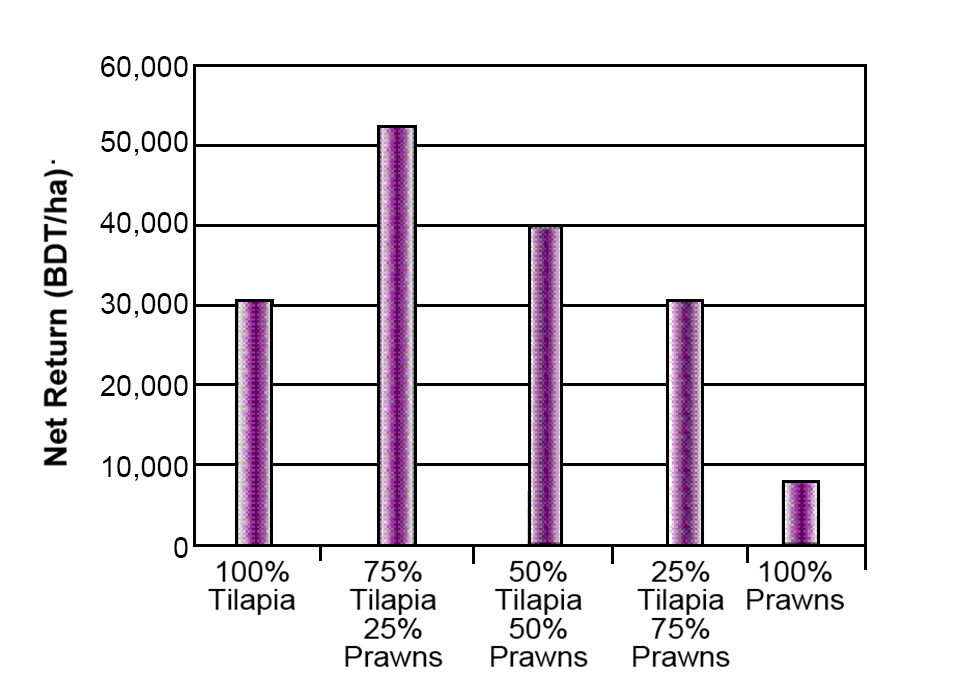
A further experiment was carried out to optimize the total stocking density using the 75 percent tilapia:25 percent prawn stocking ratio. When stocking densities of 20,000; 30,000; and 40,000 animals/ha were compared, the authors concluded that a density of 30,000/ha was the best for periphyton-based systems, although the higher density provided rather similar results. With a 3:1 ratio of tilapia and prawns, this density of 30,000/ha resulted in net production of 2,209 kg tilapia and 163 kg prawns/ha during a 105-day culture period (Fig. 4). The net return was 78,000 taka ($1,126) in this combination.
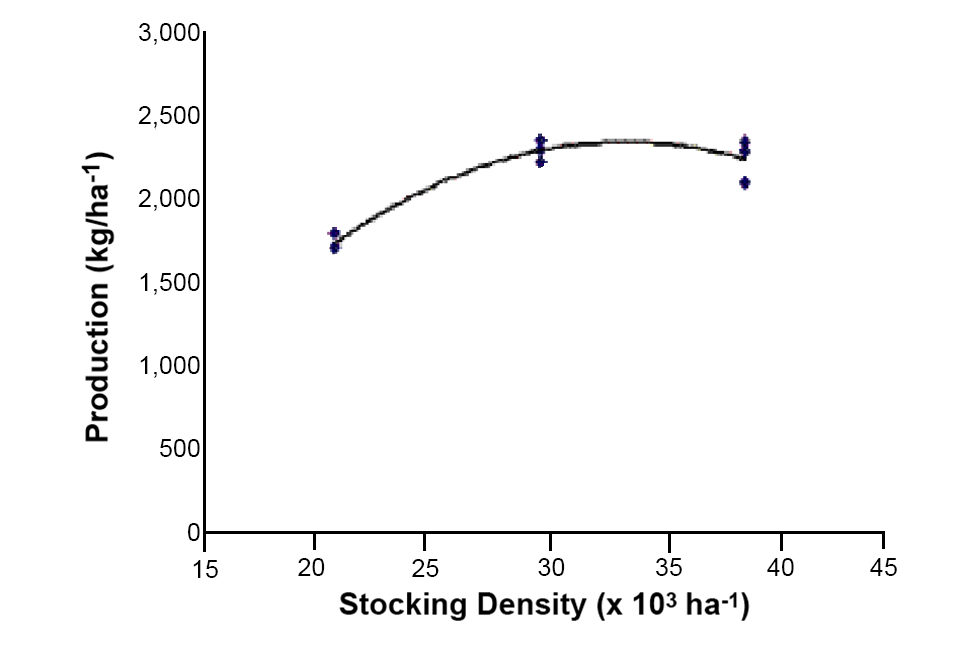
Feed complement or replacement?
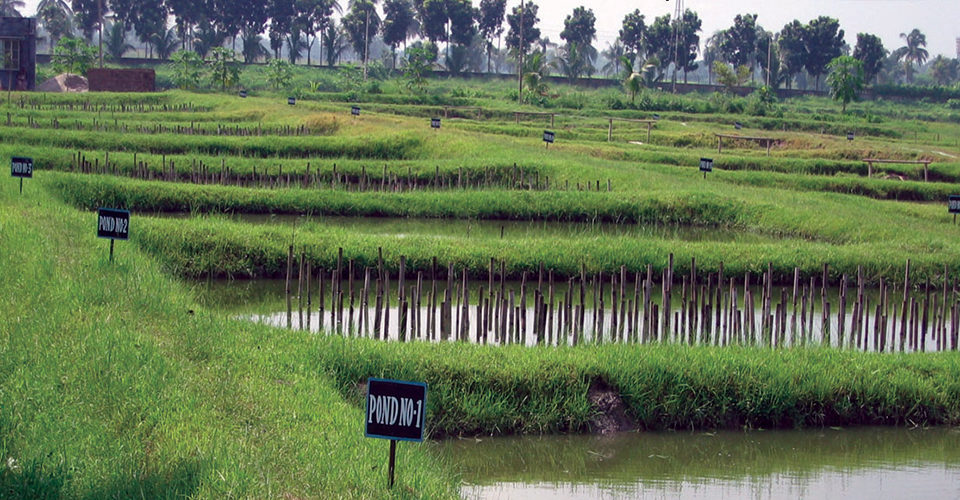
Using the best stocking ratio and density values, several combinations of periphyton substrates and supplemental feed addition were tested in farmers’ ponds: substrate plus feed (treatment SF), substrate plus no feed (SFO), feed plus no substrate (SOF), and no feed and no substrate (control).
There were no significant differences for survival, harvest weight, and net yield of both tilapia and prawns between the periphyton- and feed-driven systems (Table 1), indicating that periphyton can replace supplemental feeding. However, supplemental feed further increased tilapia production by 28 percent and prawn production by 61 percent in ponds with substrates, indicating the complementary nature of periphyton and supplemental feed in earthen ponds.
Uddin, Yield parameters of tilapia and prawns, Table 1No Substrate
| Yield Parameters | Treatment Substrate Plus Feed | Treatment Feed Only | Treatment Substrate Only | Treatment No Feed, No Substrate |
|---|---|---|---|---|
| Tilapia | ||||
| Survival (%) | 76.00 ± 2.00 | 68.00 ± 3.00 | 66.00 ± 4.00 | 54.00 ± 4.00 |
| Feed-conversion ratio | 1.23 ± 0.02 | 1.39 ± 0.06 | – | – |
| Harvest weight (g) | 120.00 ± 6.02 | 109.00 ± 7.00 | 108.00 ± 5.00 | 74.00 ± 10.00 |
| Net yield (kg/ha) | 1,940.00 ± 95.00 | 1,594.00 ± 171.00 | 1,517.00 ± 109.00 | 829.00 ± 62.00 |
| Prawns | ||||
| Survival (%) | 58.00 ± 7.00 | 43.00 ± 2.00 | 52.00 ± 8.00 | 32.00 ± 4.00 |
| Harvest weight (g) | 38.00 ± 5.00 | 26.00 ± 5.00 | 28.00 ± 6.00 | 16.00 ± 2.00 |
| Net yield (kg/ha) | 153.00 ± 28.00 | 73.00 ± 12.00 | 95.00 ± 23.00 | 32.00 ± 8.00 |
As the experiment was conducted in rain-fed seasonal ponds, farmers had to sell before the ponds dried out when prices were low. Nevertheless, net margins were 55,700 taka ($804)/ha in SF ponds; 41,500 taka ($599)/ha in SOF ponds; and 51,000 taka ($736)/ha in SFO.
Interestingly, although the contribution of prawns to the total production volume was only 4-7 percent, they contributed 22-32 percent of the total sales value. Therefore, even at low density, freshwater prawns contribute an important fraction of farming revenue in tilapia-prawn periphyton-based ponds.
Organic options
There are growing consumer perceptions, especially in the developed world, that organically produced food products are safer and healthier for people and the environment. However, one of the main difficulties with organic aquaculture is that fish feeds must be organic in origin. This strongly limits the use of the main sources of protein used in conventional aquaculture feeds and increases the cost of feeds produced organically.
On the other hand, organic standards encourage the use of food sources of biological origin not suitable for human consumption. Periphytic communities are one such food source that fits the criteria for responsible and organic aquaculture. Periphyton-based production may open opportunities to produce and promote organic products in export and domestic markets, while also providing opportunities for small-scale farmers.
(Editor’s Note: This article was originally published in the January/February 2007 print edition of the Global Aquaculture Advocate.)
Now that you've reached the end of the article ...
… please consider supporting GSA’s mission to advance responsible seafood practices through education, advocacy and third-party assurances. The Advocate aims to document the evolution of responsible seafood practices and share the expansive knowledge of our vast network of contributors.
By becoming a Global Seafood Alliance member, you’re ensuring that all of the pre-competitive work we do through member benefits, resources and events can continue. Individual membership costs just $50 a year.
Not a GSA member? Join us.
Authors
-
M.S. Uddin
Department of Fisheries
Bangladesh Ministry of Fisheries and Livestock
Dhaka, Bangladesh[108,110,46,114,117,119,64,110,105,100,100,117,46,102,102,105,114,97,104,115]
-
Dr. M.C.J. Verdegem
Aquaculture and Fisheries Group
Wageningen Institute of Animal Sciences
Wageningen University
Wageningen, The Netherlands -
Dr. M.E. Azim
Institute of Aquaculture
University of Stirling
Scotland, United Kingdom -
Dr. M.A. Wahab
Department of Fisheries Management
Bangladesh Agricultural University
Mymensingh, Bangladesh
Tagged With
Related Posts
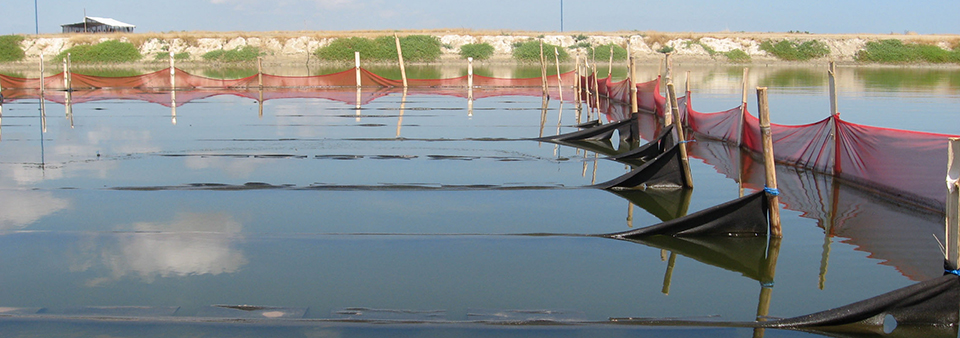
Aquafeeds
Periphyton domestication offers feed in shrimp culture
Fixed microbial communities grown as periphyton on immersed substrates present advantages in terms of pond productivity and carbon and nutrient absorption from water. Periphyton can reduce feed inputs as well as increase growth and survival rates in shrimp.
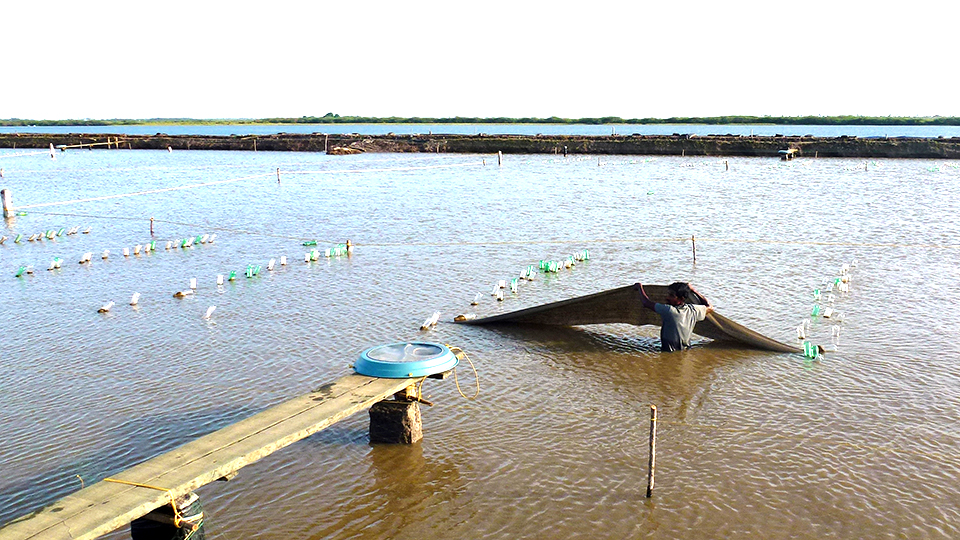
Health & Welfare
Nitrogen isotope for evaluating protein uptake in biofloc systems
Measurements of nitrogen isotope uptake can enable more efficient study of feed utilization in whole aquaculture pond systems.
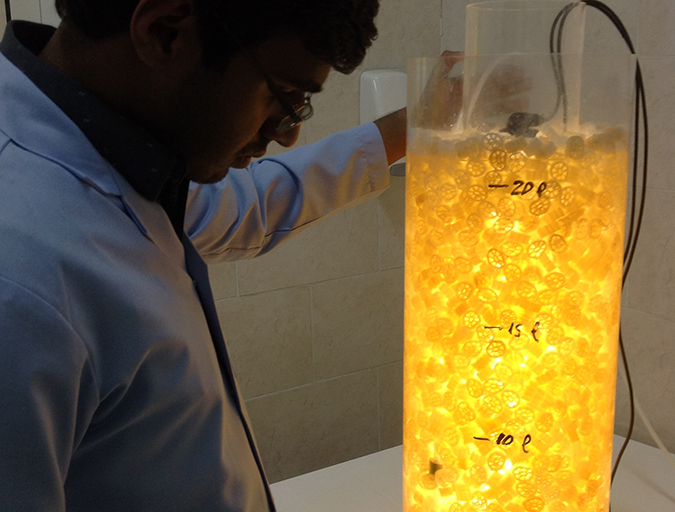
Aquafeeds
Novel reactor developed for indoor, high-density production of diatoms
The development of this reactor for the indoor cultivation of non-suspended microalgae like important diatoms such as Amphora spp., and the cellular dry matter values produced in this study will help bio-filming science support the development and improvement of in situ feed supplementation for fish and shrimp ponds, particularly in desert environments.
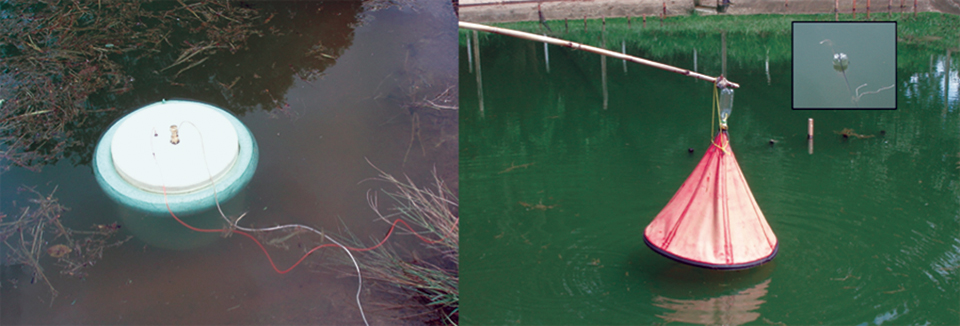
Responsibility
Greenhouse gas emissions from aquaculture
To quantify the carbon dioxide and methane fluxes in tropical earthen ponds, the authors used freshwater prawn farming managed according to different strategies as a model.


